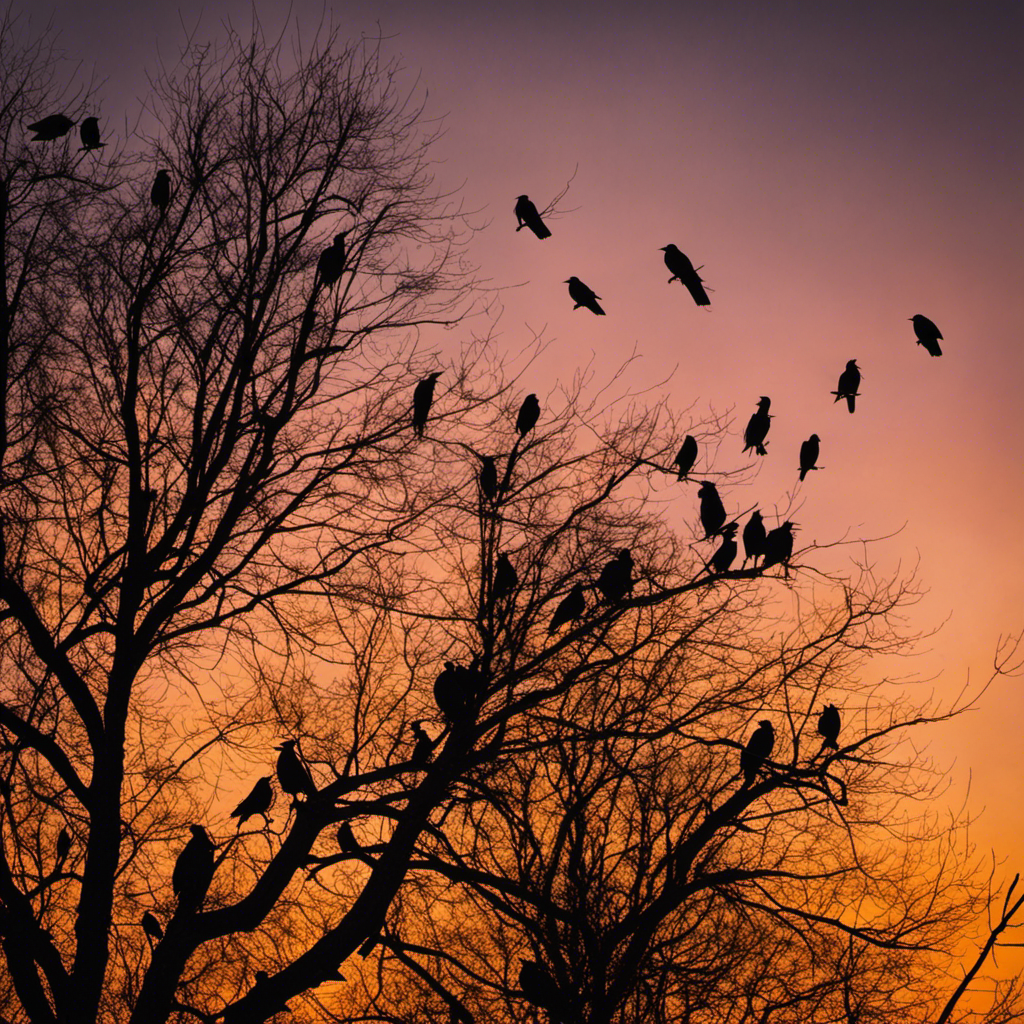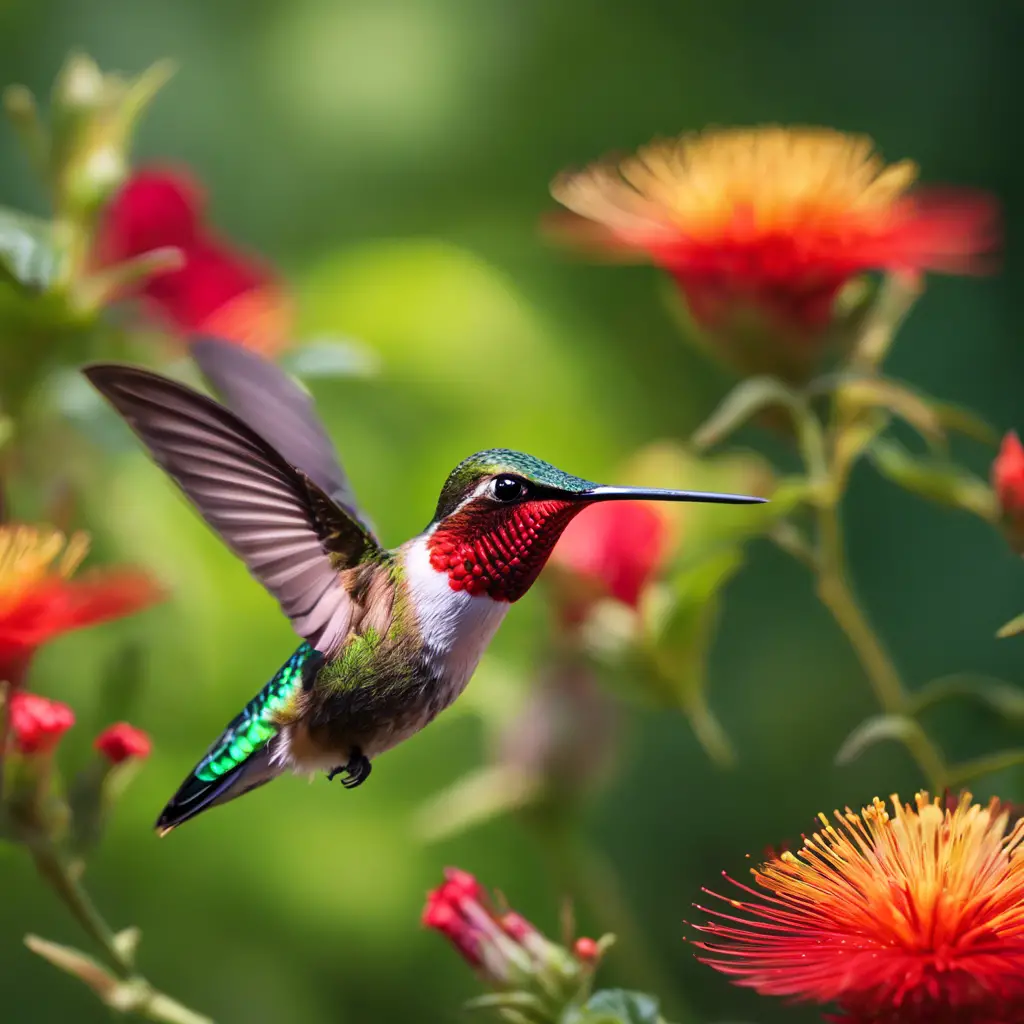Illinois is home to a diverse range of avian species, including several notable black birds. This article aims to provide a comprehensive overview of the black bird species commonly found in Illinois.
By examining their physical characteristics, habitats, and behavioral patterns, readers will gain a deeper understanding of these intriguing creatures.
From the striking Red-winged Blackbird to the adaptable European Starling, this article delves into the scientific and objective details surrounding these black birds, catering to an audience seeking a thorough comprehension of Illinois’ avian population.
Key Takeaways
- Red-winged Blackbirds are a highly migratory species with a population of approximately 30,000 nesting in Illinois wetlands.
- The Common Grackle is a highly adaptable bird species found throughout North America, known for building nests in trees, shrubs, and man-made structures.
- The European Starling is an invasive bird species in Illinois that has negatively impacted native bird populations by outcompeting them for nesting sites and food resources.
- The Rusty Blackbird and Bobolink are threatened bird species in Illinois, facing population declines due to habitat loss, pollution, climate change, and land-use changes. Conservation efforts are being made to monitor populations and identify critical habitat areas.
Red-winged Blackbird

A population of approximately 30,000 Red-winged Blackbirds has been observed nesting in the wetland habitats of Illinois.
The Red-winged Blackbird, scientifically known as Agelaius phoeniceus, is a common bird species found throughout North America. These birds are known for their distinctive red and yellow shoulder patches on their black feathers, which give them their name.
Red-winged Blackbirds are highly migratory, with populations in Illinois typically migrating to southern states during the winter months. However, some individuals may choose to overwinter in Illinois if food sources are sufficient.
Breeding habits of Red-winged Blackbirds involve males defending territories and attracting females through their iconic song displays. Females construct cup-shaped nests in marshes, often hidden among dense vegetation. They lay an average of 3-4 eggs per clutch and both parents participate in raising the young.
Common Grackle
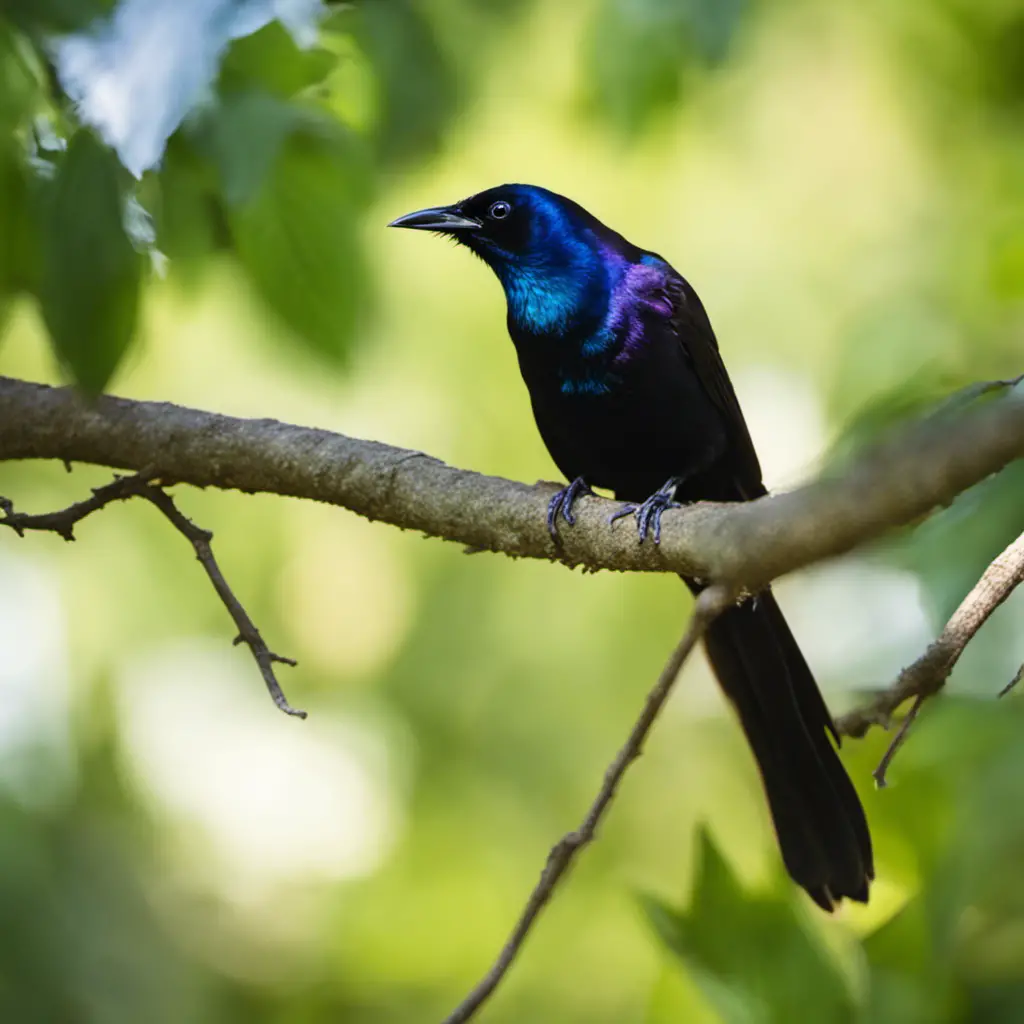
The Common Grackle, known for its glossy black plumage and piercing yellow eyes, is a highly adaptable bird species that can be found throughout North America, and it often forms large flocks during the winter months. This species is known for its nesting habits and population trends. Common Grackles build their nests in trees, shrubs, and even man-made structures, such as buildings and telephone poles. They construct their nests using twigs, grass, and other plant materials. The female lays clutches of 4-7 eggs, which she incubates for about two weeks. The population of Common Grackles has been stable overall, with some regional fluctuations. However, in recent years, there has been concern over declines in certain areas due to habitat loss and pesticides. Efforts are being made to monitor and conserve this adaptable bird species.
| Nesting Habits | Population Trends | Conservation Efforts |
|---|---|---|
| Nests in trees, shrubs, and man-made structures | Stable overall, with regional fluctuations | Monitoring and conservation programs in place |
| Uses twigs, grass, and other plant materials for nest construction | Concerns over declines in certain areas | Efforts to mitigate habitat loss and pesticide use |
| Female lays clutches of 4-7 eggs | ||
| Incubation period of about two weeks |
European Starling
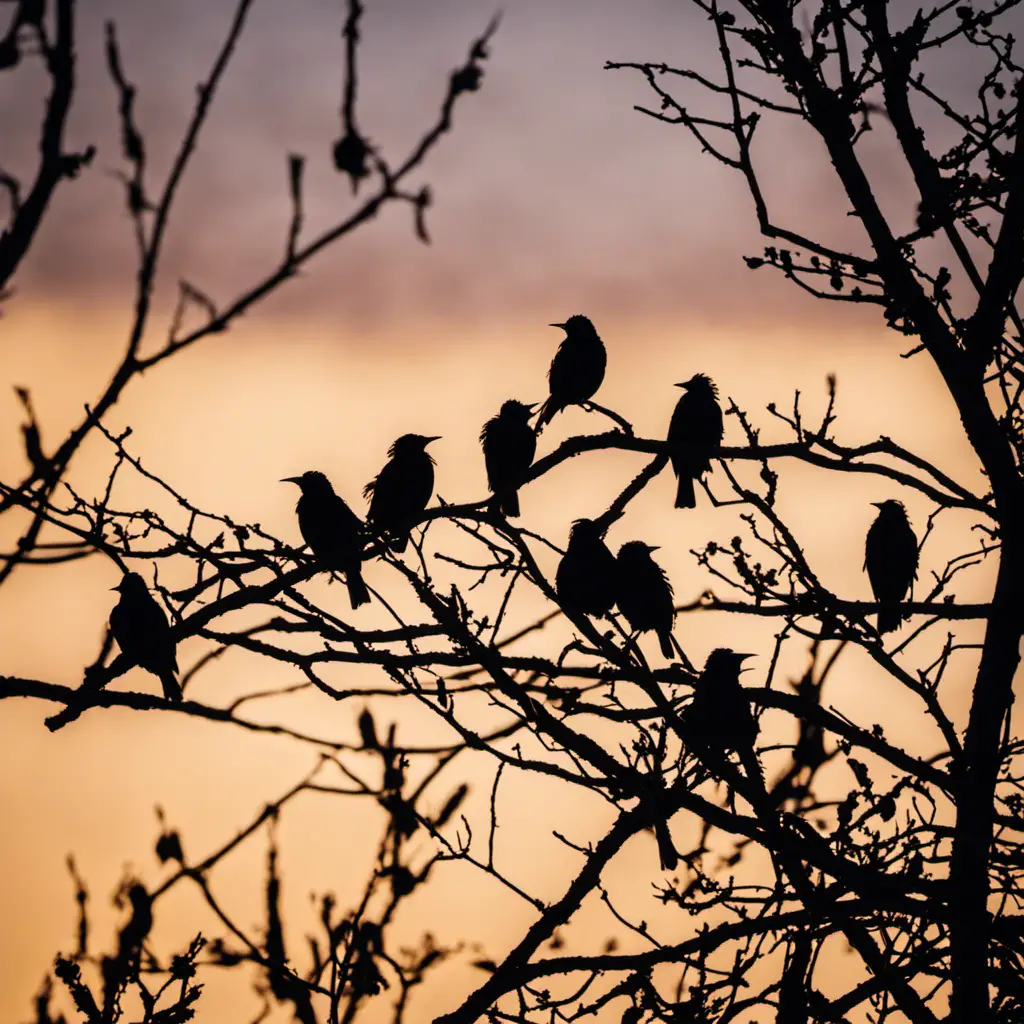
European Starlings, known for their iridescent plumage and melodic songs, are an invasive bird species that has rapidly spread throughout North America. Originally introduced to the continent in the late 1800s by a group of individuals seeking to establish all the birds mentioned in Shakespeare’s works, the European Starling population has exploded, reaching an estimated 200 million individuals in the United States alone.
These birds have adapted well to a wide range of habitats, including urban and agricultural areas, forests, and grasslands. Their diet primarily consists of insects and fruits, but they also consume seeds and grains. European Starlings exhibit highly social behavior patterns, often forming large flocks and engaging in synchronized flight displays.
However, their rapid expansion has had detrimental effects on native bird populations, outcompeting them for nesting sites and food resources. This has led to declines in several cavity-nesting species, including the Eastern Bluebird and the Purple Martin. Efforts are being made to manage European Starling populations and mitigate their impact on native birds through measures such as nest box monitoring and selective control methods.
Rusty Blackbird
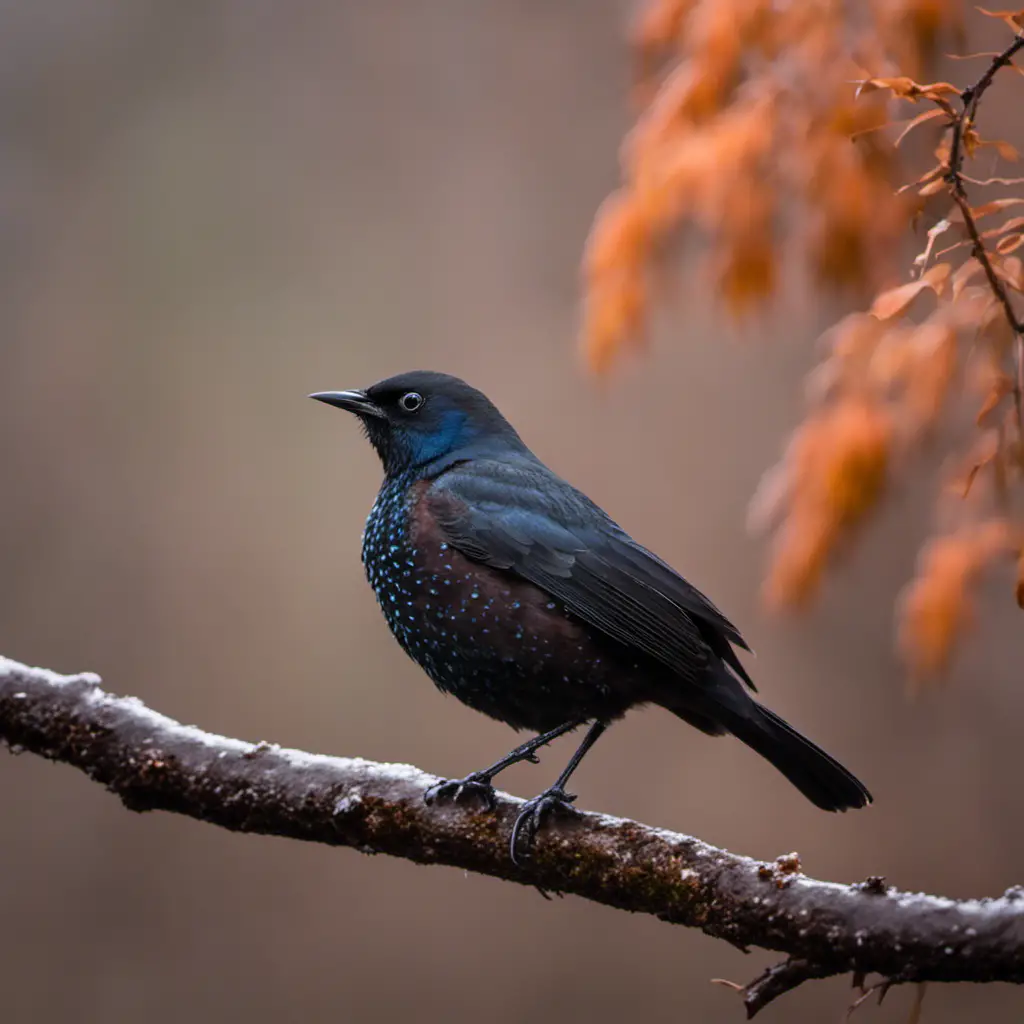
Observing the declining population of Rusty Blackbirds is crucial in understanding the factors contributing to their decline and developing effective conservation strategies. These birds, once abundant across North America, have experienced a significant decrease in numbers in recent years.
To paint a picture for the audience, here are some key points to consider regarding Rusty Blackbirds:
Rusty Blackbird habitat: These birds prefer wetland areas, including bogs, swamps, and forested wetlands. They rely on these habitats for nesting, foraging, and breeding.
Factors contributing to their decline: Habitat loss, pollution, climate change, and changes in land-use practices have all played a role in the decline of Rusty Blackbird populations.
Conservation efforts: Various organizations and researchers are working to study and protect Rusty Blackbirds. This includes monitoring their populations, identifying critical habitat areas, and implementing conservation measures.
Collaborative approach: Conservation efforts involve partnerships between government agencies, non-profit organizations, and the public to ensure the long-term survival of Rusty Blackbirds.
Research needs: Further research is needed to better understand the specific threats facing Rusty Blackbirds and to develop targeted conservation strategies to address these challenges.
Bobolink
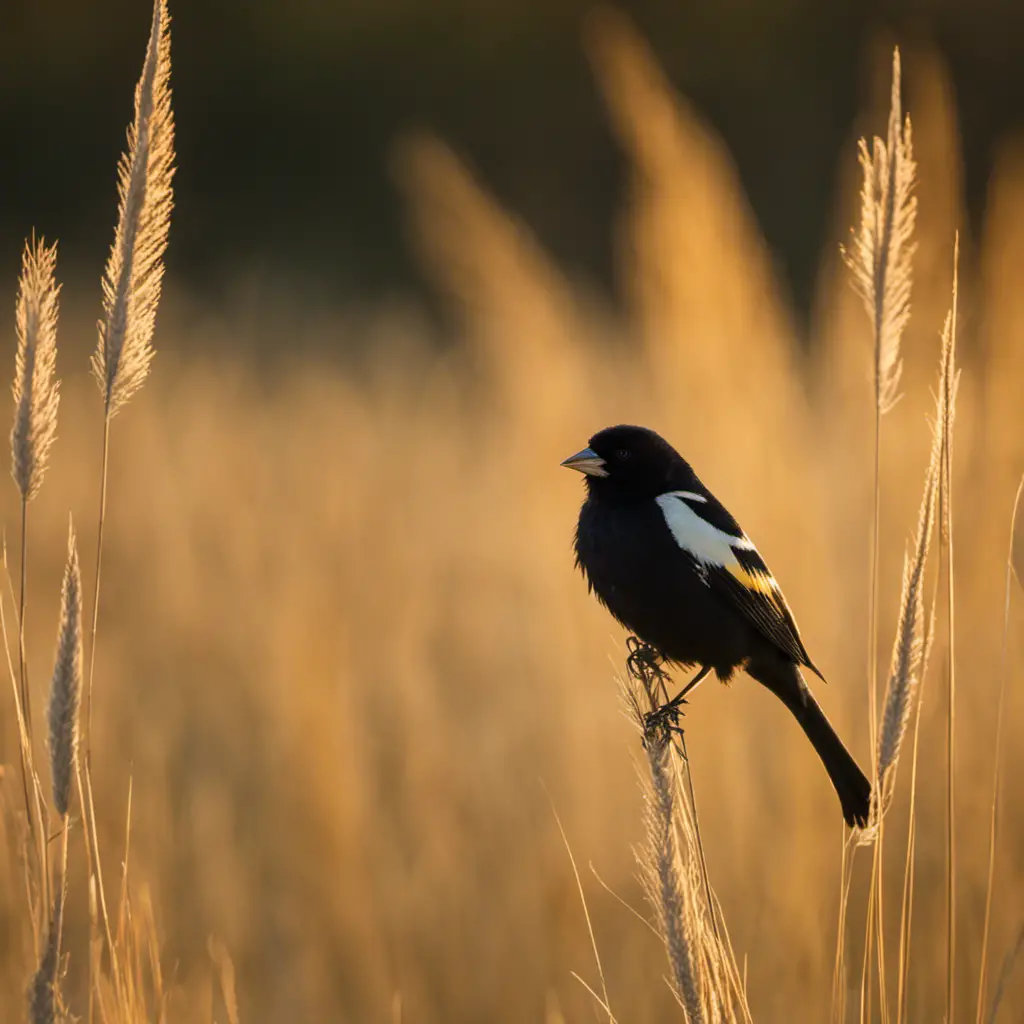
In the context of black bird populations in Illinois, the decline of the Rusty Blackbird serves as a stark reminder of the importance of understanding the factors contributing to their decrease, just as we now turn our attention to the conservation efforts and research needs for the Bobolink.
The Bobolink, a migratory bird known for its melodious song, has also experienced a decline in recent years. To address this issue, it is crucial to investigate the factors influencing the Bobolink’s habitat and migration patterns.
Research suggests that the loss of grassland habitats due to agricultural practices and urbanization has led to a decline in suitable breeding grounds for the Bobolink. Additionally, changes in climate patterns and land use have impacted their migration routes and availability of stopover sites.
Understanding and conserving the Bobolink’s habitat and migration patterns are essential for the long-term survival of this species in Illinois.
Brewer’s Blackbird
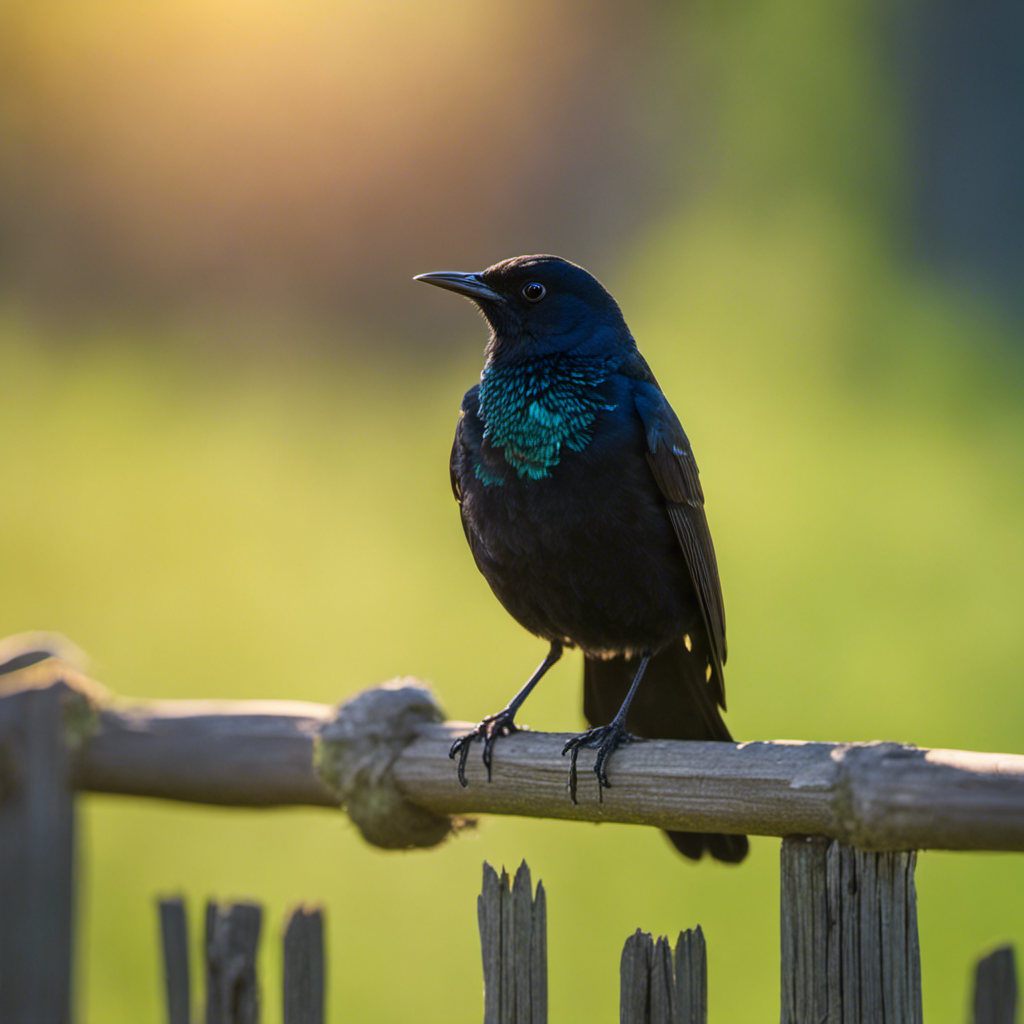
Having adapted well to urban environments, Brewer’s Blackbird populations have thrived in Illinois due to their ability to exploit human-altered habitats. These birds exhibit interesting mating habits and have specific habitat preferences.
Here are some key points to understand about Brewer’s Blackbirds:
Mating Habits:
They form monogamous pairs during the breeding season.
Males engage in elaborate courtship displays to attract females, including puffing up their feathers and singing complex songs.
Females choose mates based on the quality of the male’s display and territory.
Habitat Preferences:
Brewer’s Blackbirds prefer open habitats such as grasslands, agricultural fields, and urban areas.
They are often found near human settlements, taking advantage of food sources like garbage and spilled grain.
They build their nests in trees, shrubs, or even on buildings, using a variety of materials such as grass, twigs, and mud.
Brown-headed Cowbird
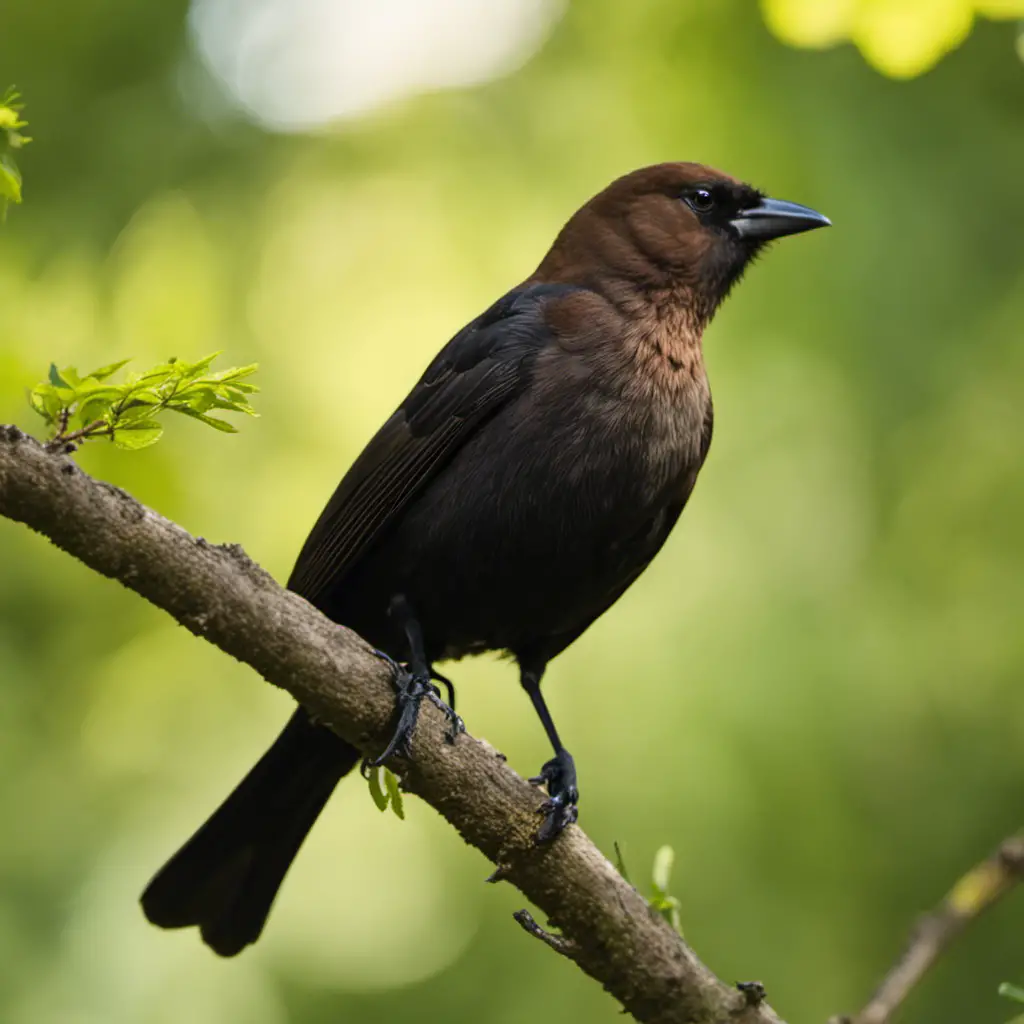
While Brewer’s Blackbirds have thrived in Illinois, the presence of Brown-headed Cowbirds in the state raises concerns about their parasitic nesting behavior.
Brown-headed Cowbirds (Molothrus ater) are brood parasites, meaning they lay their eggs in the nests of other bird species, leaving the host birds to raise their young. This behavior can negatively impact the reproductive success of the host species.
Brown-headed Cowbirds are native to grasslands, but they have adapted well to human-altered landscapes, including agricultural areas and urban environments. They primarily feed on seeds, insects, and small fruits.
Conservation efforts for Brown-headed Cowbirds focus on managing their populations to minimize their impact on host bird species. This includes monitoring cowbird populations, implementing control measures when necessary, and creating suitable habitats for host species.
It is important to strike a balance between preserving biodiversity and managing the impacts of parasitic species on native bird populations.
Eastern Towhee

The Eastern Towhee, a common bird species found in Illinois, exhibits distinct black and orange plumage, making it easily recognizable in the field. This medium-sized bird measures about 7-8 inches in length and has a wingspan of approximately 9-11 inches.
Here are some key features of the Eastern Towhee:
- The male Eastern Towhee has a black body with a contrasting orange belly and sides.
- It has a striking white patch on its wings that is visible during flight.
- The female Eastern Towhee has a similar color pattern but is slightly duller in appearance.
- These birds are primarily found in thickets, shrubby areas, and early successional habitats.
- They are known for their distinctive ‘drink-your-tea’ song, which is often heard during the breeding season.
The Eastern Towhee is a ground-dwelling bird that forages for insects, seeds, and berries. It is commonly observed scratching the ground with its feet to uncover food. During the breeding season, males establish territories and engage in courtship displays, including hopping and wing flicking.
Overall, the Eastern Towhee is an interesting bird species to observe in its natural habitat.
Common Raven
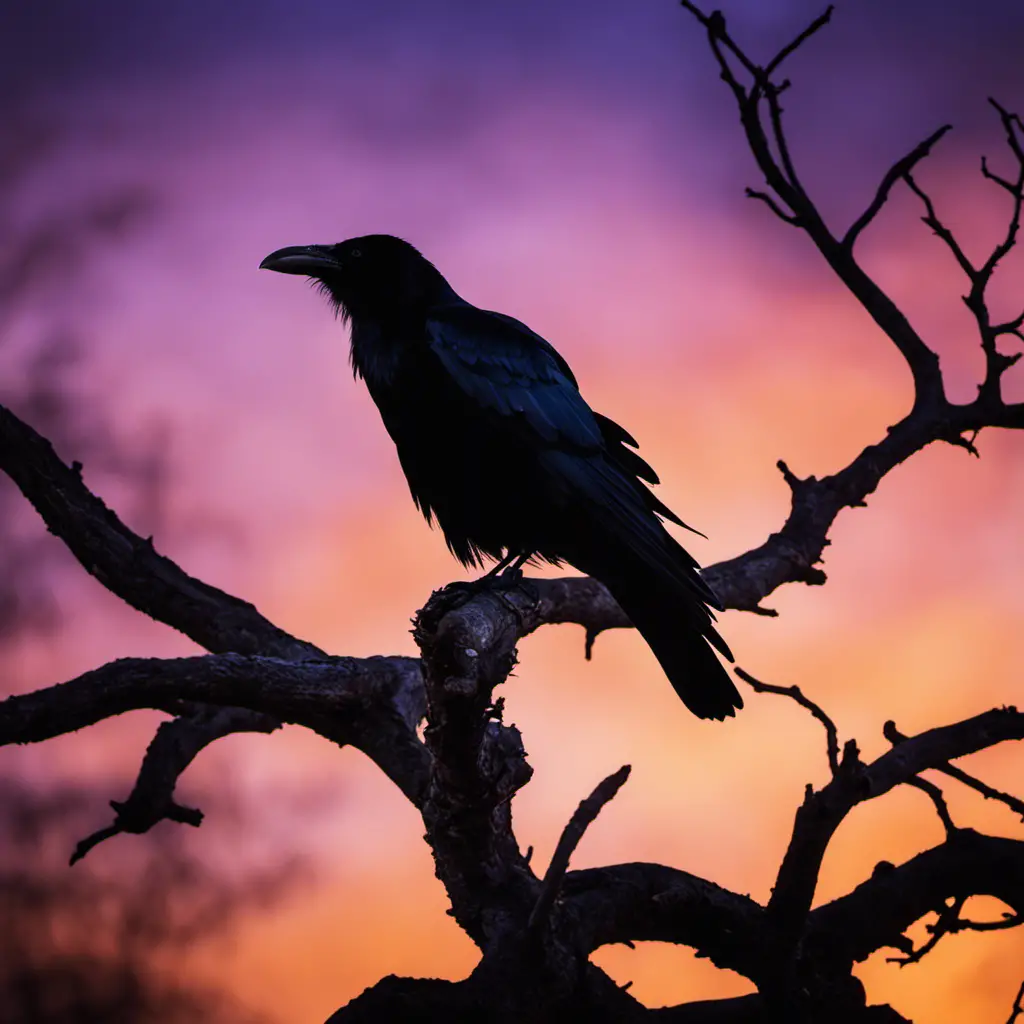
With its glossy black feathers and impressive intelligence, the Common Raven is a captivating bird species often associated with folklore and mythology.
These birds are known for their adaptability and can be found in a variety of habitats across North America, including forests, deserts, and even urban areas.
Common Ravens are highly social and often form large groups, called ‘unkindnesses,’ which can be seen soaring through the sky or perching on tree branches.
Their migration patterns are not well understood, as some individuals may stay in one area year-round while others may travel long distances.
When it comes to nesting habits, Common Ravens build large, sturdy nests made of sticks and line them with softer materials such as grass and fur.
These nests are typically located in trees or on cliff ledges, providing a safe and secure place for their eggs and young.
American Crow
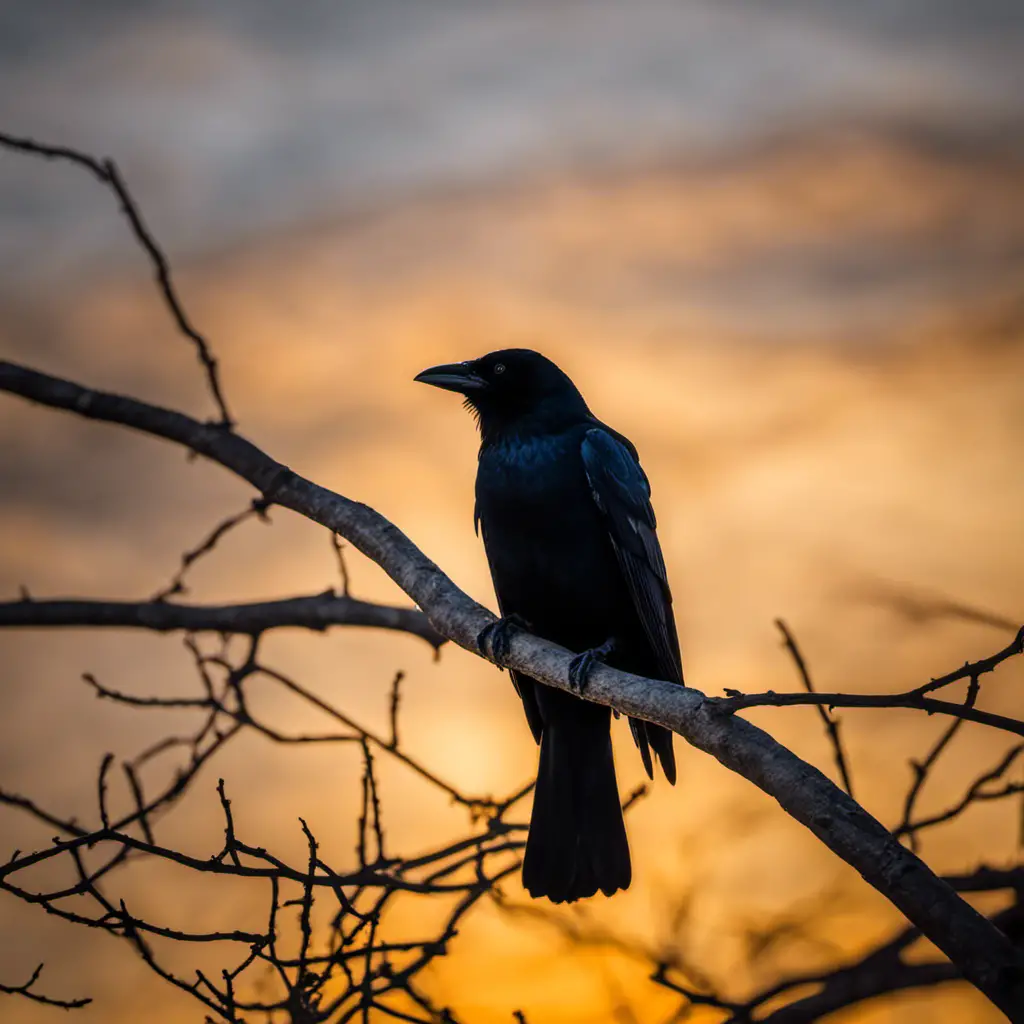
Although smaller in size than the Common Raven, the American Crow is another black bird species found in Illinois that is known for its intelligence and adaptability. The American Crow is a common sight in urban, suburban, and rural areas throughout the state.
Here are some key aspects of the American Crow’s habitat and behavior:
Habitat: The American Crow is highly adaptable and can be found in a wide range of habitats, including forests, fields, parks, and even city streets.
Diet: American Crows are omnivorous, feeding on a variety of food sources such as insects, small mammals, fruits, grains, and carrion.
Vocalizations: Crows are known for their loud and varied calls, which they use for communication and to establish territory.
Social Behavior: American Crows are highly social birds, often seen in large groups called ‘murders.’ They engage in cooperative breeding and work together to defend their territory.
Tool Usage: American Crows are known for their problem-solving abilities and have been observed using tools to obtain food.
Overall, the American Crow is a highly adaptable and intelligent bird species with fascinating behaviors and a wide-ranging habitat in Illinois.
Orchard Oriole

During the breeding season, Orchard Orioles can be spotted in the woodlands and open areas of Illinois. These small, vibrant birds are known for their bright orange plumage and distinctive songs. The Orchard Oriole’s preferred habitat includes deciduous forests, orchards, and riparian areas. They build their nests in the upper branches of trees, using grasses, plant fibers, and spider webs.
Orchard Orioles are migratory birds, spending their winters in Central and South America and returning to the breeding grounds in North America during the spring and summer. Their migration patterns follow a long-distance route, with some individuals traveling over 3,000 miles each way.
Conservation efforts for the Orchard Oriole population focus on protecting and restoring their preferred habitat. This includes preserving woodlands and riparian areas, as well as promoting sustainable agricultural practices in orchards. Additionally, efforts to reduce pesticide use and create awareness about the importance of these birds in ecosystems are crucial for their conservation.
Baltimore Oriole

The Baltimore Oriole is a migratory bird species that is commonly found in the eastern United States during the breeding season. These vibrant birds are known for their beautiful orange plumage and melodious songs.
Here are some key facts about the Baltimore Oriole’s nesting habits and migration patterns:
Nesting habits:
Baltimore Orioles build intricate hanging nests made of plant fibers, grasses, and hair.
The female constructs the nest while the male defends the territory.
Nests are often found in the outer branches of tall trees, providing protection from predators.
The female lays 3-6 eggs, which hatch after approximately 12-14 days.
Both parents share the responsibility of feeding and caring for the nestlings.
Migration patterns:
Baltimore Orioles are neotropical migrants, spending their winters in Central and South America.
They undertake long-distance journeys, covering thousands of miles twice a year.
These birds navigate using celestial cues, landmarks, and magnetic fields.
They typically return to their breeding grounds in late April or early May.
During migration, Baltimore Orioles rely on nectar, fruits, and insects as their primary food sources.
Understanding the nesting habits and migration patterns of the Baltimore Oriole provides valuable insights into the behavior and ecology of this remarkable species.
Yellow-headed Blackbird
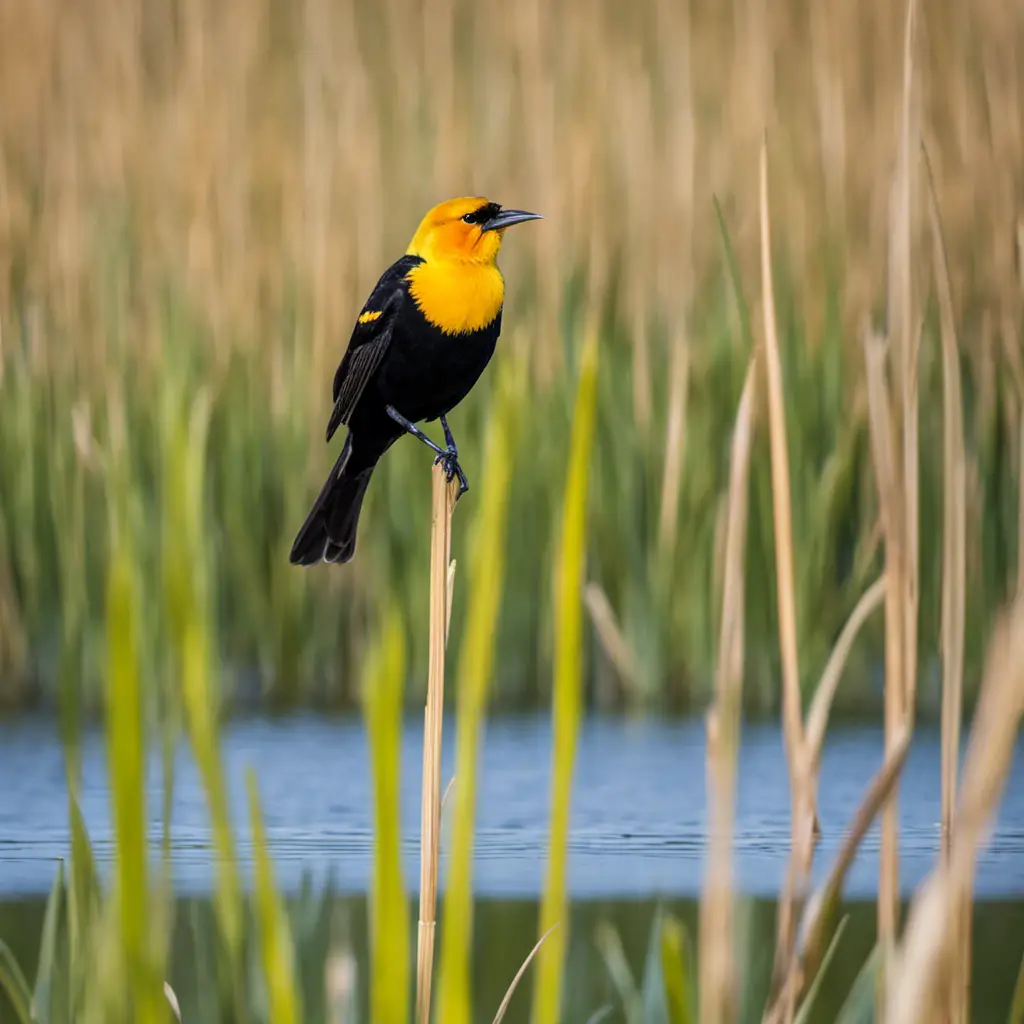
The Yellow-headed Blackbird, as well as the Baltimore Oriole, exhibits fascinating nesting habits and migration patterns. The Yellow-headed Blackbird (Xanthocephalus xanthocephalus) is a medium-sized blackbird found in North America. It is characterized by its bright yellow head and black body. This species is primarily found in wetland habitats, such as marshes and prairie potholes, where it builds its nests in cattails or other emergent vegetation. In Illinois, the population of Yellow-headed Blackbirds has been declining due to loss of wetland habitat and agricultural intensification. Conservation efforts for this species include wetland restoration and creation projects, as well as land management practices that promote suitable nesting and foraging areas. Efforts are also being made to raise awareness about the importance of preserving wetland habitats for the survival of the Yellow-headed Blackbird and other bird species.
| Common Name | Scientific Name | Habitat |
|---|---|---|
| Yellow-headed Blackbird | Xanthocephalus xanthocephalus | Wetlands, marshes, prairie potholes |
| Baltimore Oriole | Icterus galbula | Deciduous forests, woodlands, gardens |
Great-tailed Grackle

Although commonly found in southern regions of the United States, the Great-tailed Grackle (Quiscalus mexicanus) has recently been observed expanding its range into Illinois. This is an interesting development as it signifies a potential shift in the species’ habitat preferences.
The Great-tailed Grackle is a large, black bird with a long tail and a distinct call. Here are five key points about the species’ habitat and behavior:
Habitat: Great-tailed Grackles are adaptable and can be found in a variety of habitats including marshes, agricultural fields, urban areas, and wooded areas near water sources.
Feeding Behavior: They are omnivorous and have a diverse diet, feeding on insects, fruits, grains, and even small vertebrates.
Breeding: Males display elaborate courtship behaviors, including puffing up their feathers and vocalizing loudly, to attract females.
Nesting: They build large, bulky nests made of twigs and grasses high up in trees or shrubs.
Social Behavior: Great-tailed Grackles are highly social birds and form large flocks, especially during the non-breeding season.
The expansion of the Great-tailed Grackle’s range into Illinois provides an opportunity for further study of their ecological preferences and potential impacts on local ecosystems.
Boat-tailed Grackle

Boat-tailed Grackles, another species of black bird commonly found in coastal regions, have been observed exhibiting similar adaptive behavior to the Great-tailed Grackle by expanding their range into Illinois. These birds are known for their distinct boat-shaped tails and vibrant plumage. Boat-tailed Grackles typically prefer marshy habitats, nesting in vegetation near water bodies. However, recent sightings in Illinois suggest that they are adapting to a wider range of environments.
The expansion of the Boat-tailed Grackle’s range may be attributed to several factors. Firstly, changes in land use and habitat modifications may have created new suitable habitats for these birds. Secondly, the availability of food resources and nesting sites in Illinois may have attracted them to the area.
In terms of mating behavior, Boat-tailed Grackles are known for their elaborate courtship displays. Males often perch on elevated structures, fluff their feathers, and sing intricate songs to attract females. The expansion of their range in Illinois may provide them with increased opportunities for breeding and expanding their population.
Bronzed Cowbird

Given the recent sightings of the Boat-tailed Grackle expanding its range in Illinois, it is interesting to note how the presence of the Bronzed Cowbird, a brood parasite species, may impact the reproductive success of other bird species in the area.
The Bronzed Cowbird is known for its unique breeding habits and migration patterns. Here are some key points to consider:
Bronzed Cowbirds lay their eggs in the nests of other bird species, relying on them to raise their young. This parasitic behavior can result in decreased reproductive success for the host species, as they may have to invest additional resources in raising unrelated offspring.
The Bronzed Cowbird is a highly mobile species, with individuals migrating long distances to find suitable hosts for their eggs. The presence of Bronzed Cowbirds in Illinois may disrupt the natural breeding patterns of local bird populations.
Understanding the breeding habits and migration patterns of Bronzed Cowbirds is crucial for managing their impact on native bird species and maintaining ecological balance in the area.
Shiny Cowbird
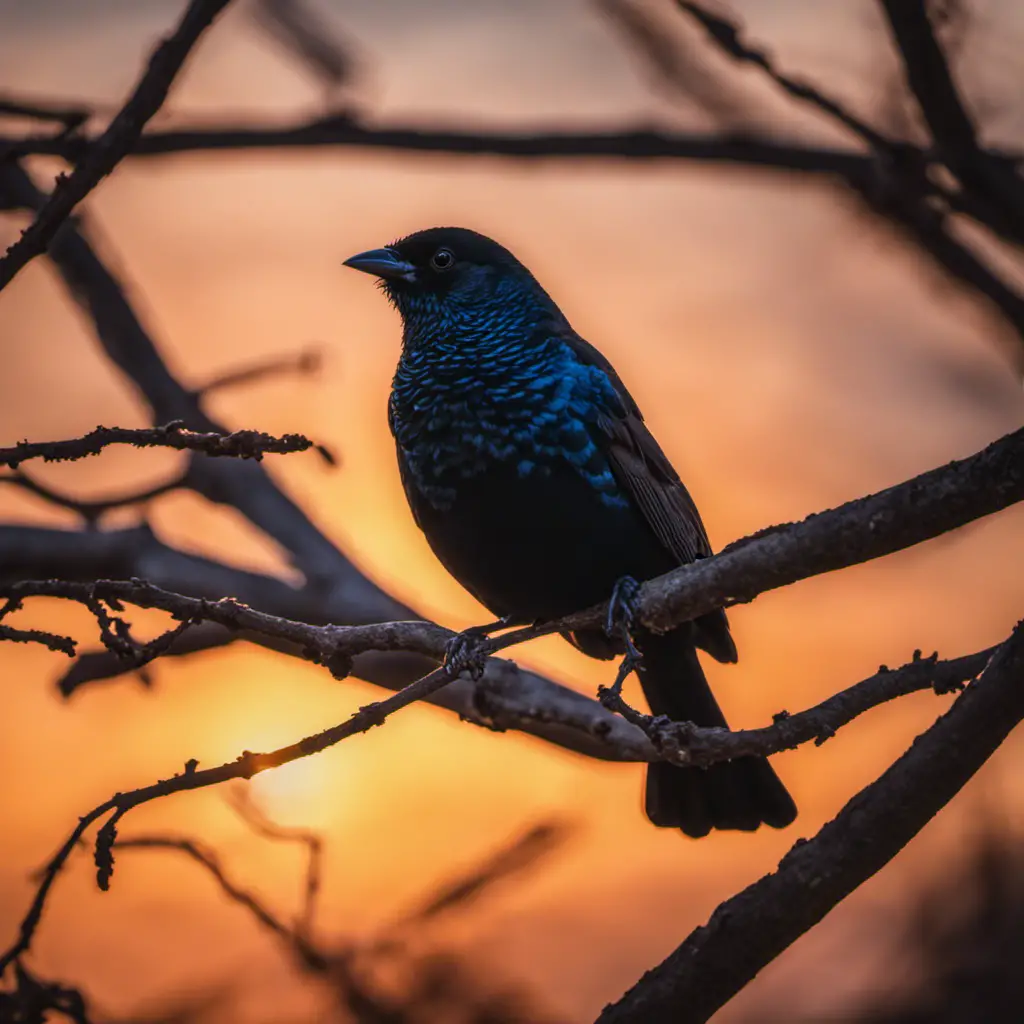
The presence of the Shiny Cowbird in Illinois raises concerns about its potential impact on the reproductive success of local bird species. The Shiny Cowbird is a brood parasite, meaning it lays its eggs in the nests of other bird species, relying on them to raise its young. This behavior can have detrimental effects on the host species, as the Shiny Cowbird eggs often hatch earlier and grow faster than the host’s own offspring, leading to competition for resources and reduced survival rates for the host chicks.
The Shiny Cowbird is native to Central and South America but has expanded its range northward due to changes in climate and habitat. Understanding the Shiny Cowbird’s migration patterns and its impact on local bird populations is crucial for developing strategies to mitigate its potential negative effects on native bird species in Illinois.
Brown-headed Nuthatch

Although the Brown-headed Nuthatch is primarily found in the southeastern United States, recent sightings in Illinois have sparked interest among ornithologists studying its range expansion.
This small songbird is known for its distinctive brown head and blue-gray plumage. It is typically found in mature pine forests, where it forages for insects and spiders among the branches.
The Brown-headed Nuthatch is also known for its unique nesting habits, as it excavates cavities in dead trees or uses existing cavities. Mating behavior in this species involves elaborate courtship displays, with males performing acrobatic flights and vocalizing to attract females.
Once a pair is formed, both male and female participate in nest construction and feeding of the young.
The recent sightings of the Brown-headed Nuthatch in Illinois raise questions about its habitat preferences and potential adaptation to new environments.
Black-capped Chickadee

During the breeding season, the Black-capped Chickadee can be found nesting in tree cavities or utilizing birdhouses for shelter. These small, agile birds are known for their distinctive black cap and bib, white cheeks, and gray back. They have a wide range across North America, including parts of Illinois.
The Black-capped Chickadee has interesting nesting habits. They excavate cavities in dead trees or use existing cavities, such as abandoned woodpecker holes. They may also use birdhouses if available. The female builds the nest using moss, grass, and bark fibers, lining it with soft materials like animal fur or feathers. The female lays a clutch of 6-8 eggs, which she incubates for about two weeks.
When it comes to feeding behavior, the Black-capped Chickadee is primarily insectivorous, but it also consumes seeds and berries. They have a unique foraging technique where they search for food in a methodical manner, moving branch by branch and examining crevices for hidden insects or seeds. They are known to cache food for later consumption, storing seeds and insects in tree bark or other suitable spots.
Here is a table summarizing the nesting habits and feeding behavior of the Black-capped Chickadee:
| Nesting Habits | Feeding Behavior |
|---|---|
| Nest in tree cavities | Insectivorous |
| Utilize birdhouses | Consume seeds |
| Excavate cavities | Eat berries |
| Use existing cavities | Cache food |
| Build nests with moss | Methodical foraging |
| Lay 6-8 eggs | Search branch by branch |
| Incubate eggs for 2 weeks | Examine crevices for hidden insects or seeds |
Tufted Titmouse
One interesting characteristic of the Tufted Titmouse’s appearance is its distinct tuft of feathers on its head, which adds to its unique charm. This small bird, measuring around 6 inches in length, can be easily identified by its gray upperparts, white underparts, and black forehead.
Here are some key points about the behavior patterns and habitat preferences of the Tufted Titmouse:
Behavior Patterns:
Highly social birds, often found in small flocks.
Agile and acrobatic, frequently seen hanging upside down.
Known for their loud and varied vocalizations, including songs, calls, and alarm notes.
Active foragers, searching for food in trees, shrubs, and on the ground.
Cache food items for later consumption.
Habitat Preferences:
Commonly found in deciduous forests, woodlands, and suburban areas with trees and shrubs.
Prefers mature forests with a mix of trees, providing a variety of food sources.
Nests in tree cavities, using natural holes or old woodpecker nests.
Understanding the behavior patterns and habitat preferences of the Tufted Titmouse can help researchers and bird enthusiasts appreciate and conserve this charming species.
Carolina Chickadee
The Carolina Chickadee, a small bird measuring around 4.75 inches in length, is known for its distinctive black cap and bib, making it easily distinguishable from other chickadee species. This species is native to the southeastern United States and can be found in a variety of habitats, including deciduous and mixed forests, woodlands, and suburban areas. Carolina Chickadees are highly adaptable and can withstand a wide range of temperatures and climates. They are social birds that form small flocks during the non-breeding season, foraging together and communicating with their characteristic chick-a-dee-dee-dee call. In terms of conservation efforts, the Carolina Chickadee is not currently considered a species of concern, but continued habitat preservation and management are important to ensure their long-term survival. The table below provides a visual representation of the Carolina Chickadee’s key characteristics.
| Carolina Chickadee | |
|---|---|
| Length | 4.75 inches |
| Color | Black and white |
| Cap and bib | Black |
| Habitat | Forests, woodlands, suburban areas |
White-breasted Nuthatch
A common sight in Illinois, two White-breasted Nuthatches can often be found foraging for insects and seeds in tree bark. These small birds are known for their distinctive appearance and behavior. Here are five key characteristics of White-breasted Nuthatches:
Nesting Habits: White-breasted Nuthatches typically excavate their own nest cavities in dead or decaying trees. They line the cavities with bark, fur, and feathers to create a soft and cozy nest for their eggs.
Feeding Behavior: These birds have a unique feeding behavior called ‘hitching,’ where they move headfirst down tree trunks and branches while searching for insects and seeds. They use their strong bills to pry open tree bark and extract their prey.
Vocalizations: White-breasted Nuthatches have a distinctive nasal call that sounds like ‘yank-yank.’ They also produce a low, repetitive ‘quank-quank’ song during courtship and territorial disputes.
Range: These nuthatches are native to North America and can be found throughout the eastern and western parts of the continent. In Illinois, they are a common resident in forests and woodlands.
Conservation: While White-breasted Nuthatches are currently not considered threatened, habitat loss and deforestation pose a potential risk to their populations. Efforts to preserve and protect their nesting habitats are important for their long-term survival.
Understanding the nesting habits and feeding behavior of White-breasted Nuthatches provides valuable insight into their ecological role and conservation needs.
House Sparrow
With its adaptability to urban environments and aggressive behavior towards native bird species, the House Sparrow has become a subject of concern and debate among ornithologists and conservationists.
The house sparrow, scientifically known as Passer domesticus, is a small passerine bird that is native to Eurasia. It was introduced to North America in the mid-19th century and has since established thriving populations across the continent.
One of the reasons for its success is its ability to adapt to urban environments, where it finds plentiful food sources and nesting sites. House sparrows are highly opportunistic breeders, with the ability to produce multiple broods in a breeding season.
This reproductive strategy, combined with their aggressive behavior towards other bird species, has led to concerns about their impact on native bird populations. Efforts are being made to better understand and manage the house sparrow’s urban adaptation and breeding habits in order to protect native bird species.
House Finch
House Finch is a small songbird species found across North America, known for its vibrant plumage and melodious songs. This species exhibits interesting breeding habits and has a diverse diet. Here are some key points about the house finch:
Breeding habits: House finches are monogamous and form pair bonds during the breeding season. They build cup-shaped nests using twigs, grass, and other plant materials. The female lays 3-5 eggs and both parents take turns incubating them for about two weeks.
Diet: House finches have an omnivorous diet, feeding on a variety of foods. They consume seeds, berries, fruits, and insects. They are particularly fond of sunflower seeds and can often be seen at bird feeders.
Vocalizations: House finches are known for their melodious songs, which consist of a series of varied notes and trills. Males sing to attract mates and defend their territories.
Range: House finches are native to the western United States but have expanded their range across North America due to human introductions.
Plumage: Male house finches have bright red or orange-red plumage on their head, breast, and rump, while females have more subdued colors, often with streaks and stripes.
Overall, the house finch is a fascinating bird with unique breeding habits and a diverse diet. Its vibrant plumage and melodious songs make it a delight to observe in the wild.
American Goldfinch
The American Goldfinch, a small songbird native to North America, molts its feathers twice a year, transitioning from a vibrant yellow plumage in the summer to a duller olive-brown color in the winter. This adaptation helps the goldfinch blend in with its surroundings during different seasons.
In terms of migration patterns, American goldfinches are known to be partially migratory. While some individuals migrate to southern regions during the winter, others remain in their breeding grounds all year round.
The American goldfinch is primarily a seed-eater, with its diet consisting mainly of seeds from various plants such as thistles, sunflowers, and dandelions. These birds have a specialized beak that allows them to extract seeds from plants. In addition to seeds, they also consume small insects and spiders, especially during the breeding season when they need additional protein for their young.
Frequently Asked Questions
Are There Any Black Bird Species in Illinois That Are Not Mentioned in the Article Sections?
There may be black bird species in Illinois that are not mentioned in the article sections. To fully explore this question, we must consider the unique behaviors and characteristics of black birds in Illinois.
What Is the Average Population of Black Birds in Illinois?
The average population of black birds in Illinois varies due to their migration patterns. It is crucial to understand their population dynamics and factors influencing their numbers to accurately determine the average population of black birds in the state.
Do Any of the Black Bird Species in Illinois Migrate?
Black birds in Illinois exhibit unique migratory patterns, with some species migrating seasonally while others remaining year-round. These birds contribute to the ecosystem by dispersing seeds, controlling insect populations, and serving as indicators of environmental health.
Are There Any Conservation Efforts in Place to Protect Black Bird Species in Illinois?
Conservation efforts play a crucial role in protecting endangered species. In Illinois, specific measures are in place to safeguard black bird species. These efforts include habitat preservation, monitoring populations, and raising awareness through education programs.
Can Black Birds in Illinois Mimic or Imitate Other Bird Species’ Songs?
Black bird species in Illinois have the ability to mimic or imitate other bird species’ songs. This is a form of communication among them. It is unclear if there is a correlation between their mimicry abilities and their population size.
Are Black Birds of Prey Common in Illinois?
Black birds of prey in illinois are commonly seen across various locations in the state. These majestic creatures, such as black hawks and black vultures, are known for their impressive hunting skills and distinct black plumage. Their presence adds a touch of awe and wonder to the diverse bird population of Illinois.
Conclusion
In conclusion, Illinois is home to a diverse range of black bird species. These include the Red-winged Blackbird, Common Grackle, European Starling, Rusty Blackbird, Bobolink, White-breasted Nuthatch, House Sparrow, House Finch, and American Goldfinch.
These species contribute to the ecological balance and biodiversity of the state’s avian population. Studying and understanding these black birds is crucial for maintaining healthy ecosystems and preserving the natural heritage of Illinois.
Further research is needed to explore their behaviors, habitats, and conservation status. This research can help us better protect and manage these species in the future.

An avid ornithologist, zoologist and biologist with an unwavering passion for birds and wild animals.
Dr. Wilson’s journey in ornithology began in childhood and led him to obtain a Ph.D. in Ornithology from the prestigious Avian Research Institute. He has worked closely with renowned experts in the field and conducted extensive research and field studies globally.

